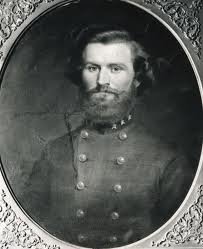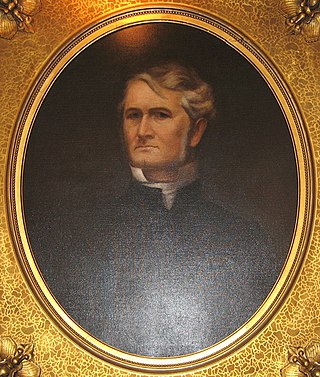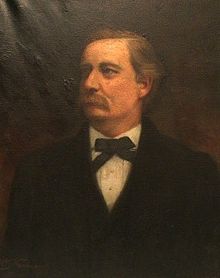
Sarah Childress Polk was the first lady of the United States from 1845 to 1849. She was the wife of the 11th president of the United States, James K. Polk.

Newton Cannon was an American politician who served as the eighth Governor of Tennessee from 1835 to 1839. He also served several terms in the United States House of Representatives, from 1814 to 1817, and from 1819 to 1823. Cannon was a long-time foe of Andrew Jackson, and spent much of his political career opposing Jacksonite policies. Cannon was succeeded as Governor of Tennessee by James K. Polk in 1839, who later became President of the United States.

Mount Olivet Cemetery is a 206-acre (83 ha) cemetery located in Nashville, Tennessee. It is located approximately two miles East of downtown Nashville, and adjacent to the Catholic Calvary Cemetery. It is open to the public during daylight hours.

Centennial Park is a large urban park located approximately two miles west of downtown Nashville, Tennessee, United States, across West End Avenue from the campus of Vanderbilt University. The 21st-century headquarters campus of the Hospital Corporation of America was developed adjacent to the park.

The Parthenon in Centennial Park, Nashville, Tennessee, United States, is a full-scale replica of the original Parthenon in Athens, Greece. It was designed by architect William Crawford Smith and built in 1897 as part of the Tennessee Centennial Exposition.

The Tennessee Performing Arts Center (TPAC) is located in the James K. Polk Cultural Center at 505 Deaderick Street in downtown Nashville, Tennessee. It occupies a city block between 5th and 6th Avenues North and Deaderick and Union Streets. The cultural center adjoins the 18-story James K. Polk State Office Building.

The Tennessee State Museum is a large museum in Nashville depicting the history of the U.S. state of Tennessee. The current facility opened on October 4, 2018, at the corner of Rosa Parks Boulevard and Jefferson Street at the foot of Capitol Hill by the Bicentennial Capitol Mall State Park. The 137,000-square-foot building includes a Tennessee Time Tunnel chronicling the state's history by leading visitors though the museum's permanent collection, a hands-on children's gallery, six rotating galleries, a digital learning center, and a two-story Grand Hall. Exhibitions include significant artifacts related to the state's history, along with displays of art, furniture, textiles, and photographs produced by Tennesseans. The museum's Civil War holdings consists of uniforms, battle flags, and weapons. There is no admission charge for visitors.

Gus Lafayette Baker was a painter, illustrator, photographer and lecturer.

The President James K. Polk Home & Museum is the presidential museum for the 11th president of the United States, James K. Polk (1795–1849), and is located at 301 West 7th Street in Columbia, Tennessee. Built in 1816, it is the only surviving private residence of United States President James K. Polk. It was designated a National Historic Landmark in 1961, and is listed on the National Register of Historic Places. As President Polk's primary historic site it is open daily for guided tours.

Randal William McGavock (1826–1863) was an American lawyer, Democratic politician, Southern planter, and colonel in the Confederate States Army. He served as the mayor of Nashville, Tennessee, from 1858 to 1859.

Mayna Treanor Avent was an American painter.
Jane Stuart was an American painter, best known for her miniature paintings and portraits, particularly those made of George Washington. She worked on and later copied portraits made by her father, Gilbert Stuart, and created her own portraits. In the early 19th century, she assumed the responsibility of supporting her family after her father's death. She first worked in Boston, but later moved to Newport, Rhode Island, where she was the first woman who painted portraits. In 2011, she was inducted into the Rhode Island Heritage Hall of Fame.

Antoinette Van Leer Polk, Baroness de Charette was an American Southern belle in the Antebellum South and French aristocrat in the Gilded Age. She was born into the planter elite, the great-niece of the 11th President of the United States James K. Polk and a member of the influential Van Leer family through her mother. She was an heiress to plantations in Tennessee and a "Southern heroine" who warned Confederate soldiers of advancing Union troops during the American Civil War. After the war, she moved to Europe, where she took to foxhunting in the Roman Campagna of Italy and the English countryside, and later became a baroness and socialite in Paris and Brittany.

Cornelius Hankins (1863-1946) was an American painter. He painted agrarian landscapes of Tennessee and portraits of Confederate veterans and politicians.

The Benjamine Rucker House is a historic mansion in Rutherford County, Tennessee, U.S..

Major Eugene Castner Lewis was an American engineer and businessman. He served as the chairman of the Nashville, Chattanooga and St. Louis Railway from 1900 to 1917. As a civic leader, he helped develop Shelby Park and Centennial Park, including the Parthenon, as well as Union Station.

Friedrich Julius Georg Dury (1817–1894) was a well-regarded Bavarian-American portrait artist who worked in both oil and pastel. He was born and educated in Würzburg, Bavaria, and Munich, where he began his career as an artist.

Sarah Polk Jetton Fall was a wealthy Nashville socialite and philanthropist. She was the great-niece and unofficially adopted daughter of former First Lady Sarah Childress Polk. Sallie's mother died when she was only a few months old. Sallie lived with her great-grandmother, who gave Sallie to her daughter Sarah after the death of Sarah's husband President James K. Polk.
Anne Gamble Kennedy was an American classical pianist, piano professor, and accompanist for the Fisk Jubilee Singers of Nashville, Tennessee.

Sara Ward Conley was an American artist from Nashville, Tennessee.



















